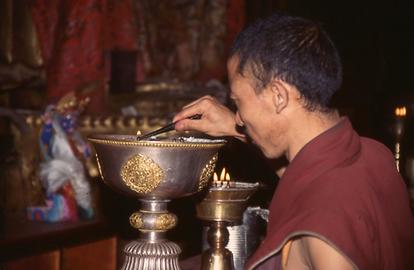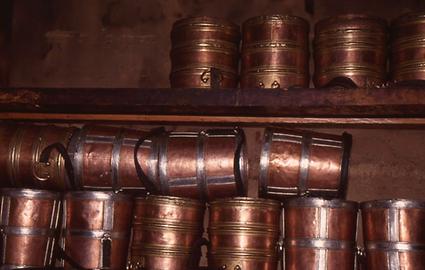Food in Tibet: Tsampa and buttertea – Austere Food in an austere Country#
ByAll photos were taken by the author in the years 1991, 1993, 1995, 1999 and 1999. They are part of the author's "Pictureflood Jontes". The author has made them graciously available to Austria-Forum and Global-Geography.org .
The Tibetan highlands was closed for foreigners for a long time when it was a sovereign state. Today, it is an autonomous Region of China but is sharply reduced in land.It is in a climatically very disadvantaged area. The valley of the mighty river Tsangpo, which flows in India as Brahmaputra into the sea, is on average at an altitude of 3500 meters. Above, there is the chain of the Himalayan mountains, the highest peaks on world.
However, there is an astonishing vegetation that allows men and animals to feel confortable in a cultural and physical way if they still eat traditionally. The only cereal that grows in heights up to about 4000 meters is barley. The admirable Yak-cattle graze even up to 6000 meters. Up to 3000 meters there are fruit trees, especially the blooming apricot tree that bears fruits. Buckwheat is also growing at these altitudes.



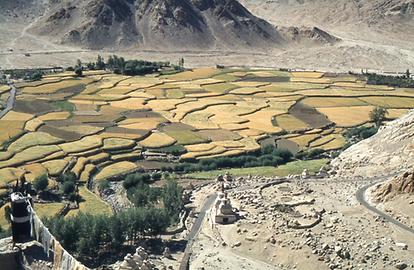


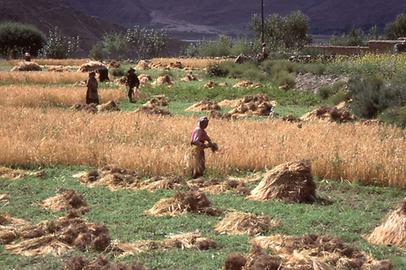

Buckwheat flourishes because it is not a grass but belongs to the knotweed family. Also apricot trees grow up to high altitudes and provide valuable vitamins for the long winter months.


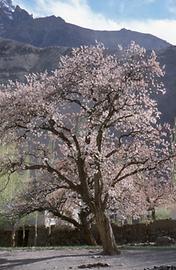

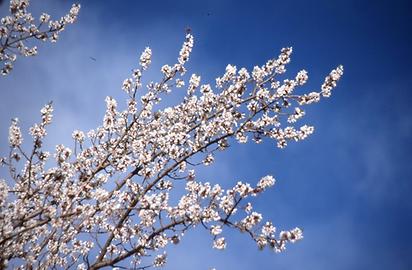
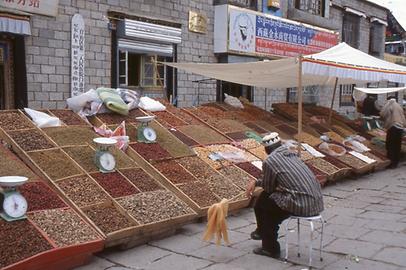
Barley is not suitable for baking bread. It lacks the thickener. It is used to brew beer as is done today around the world. Tibet has an own tradition with its alcoholic barley beverage Chang.
Barley flour as tsampa represents a large part of the traditional Tibetan food. Barley grains are hulled, and shaken with heated sand until the grains can be mashed into flour. With strong buttered tea, the Bö cha, the flour is formed into a dough which is eaten raw. Sometimes cheese is added which makes it even richer. Also dried fruits are added from time to time. In monasteries this standard food is prepared in big quantities by a whole team.


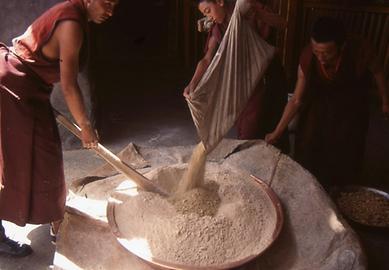



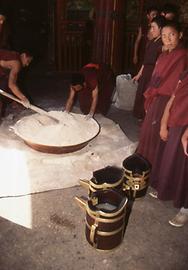


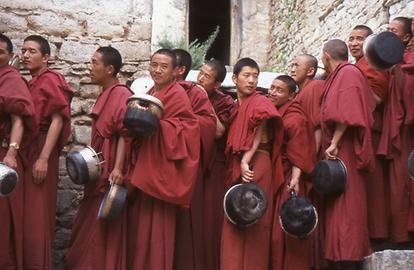
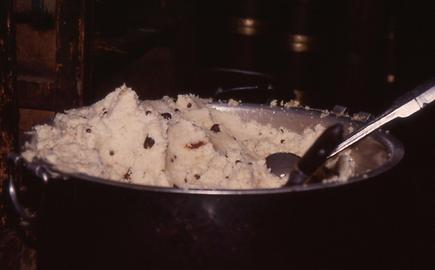
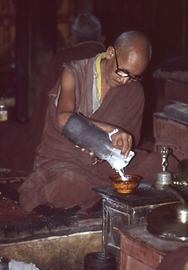


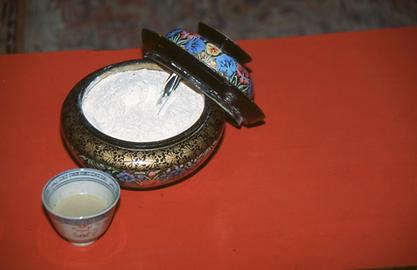
The second ingredient for Tsampa is the butter tea Bö cha. Since olden times the tea leaves don’t come from the nearer India, but are brought via trade routes from China. The inferior teas are pressed into tea bricks which serve as a trading unit. Mixed with butter and natural salt from the Tibetan salt seas, which contains soda, a brew is prepared which has to cook for some time.
Tibetans are drinking Tsampa in enormous quantities. It warms the body. Due to the coffeine the blood circulation is kept stable and it covers the fluid requirements. For monks to drink Tsampa is the only way to keep warm in the unheated monasteries in long winters. Up to forty cups are the daily consumption and all ceremonies and rituals are interrupted by tea breaks.
The traditional drinking vessel is a carved wooden bowl. Tea kettles are boiling in kitchens all the time. The life-giving liquid is transported to the people in transport cans. The brew is homogenized with large clumps of butter in a mixing vessel. It turns into something that is more like a soup than the usual black tea.
When once thousands of monks came together to great festivals and examinations of the highest lamas, huge quantities of tea had to be prepared. The problem was mainly to get the necessary quantities of fuel.
The Austrian mountaineers Heinrich Harrer and Peter Aufschnaiter, who spent several years in Tibet, planted fast-growing trees like the poplar which then provided the necessary firewood. In some monasteries there are still old tea kettles which are not used today but represent excellent examples of Tibetan bronze casting art.

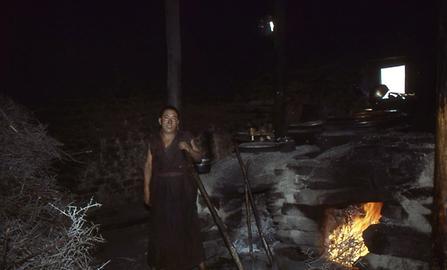
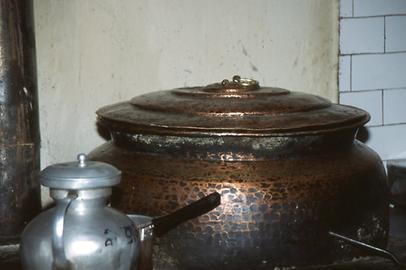

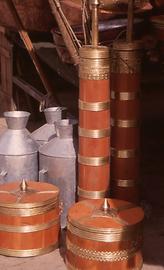
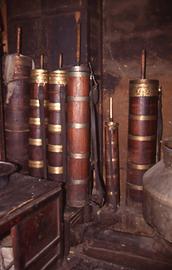


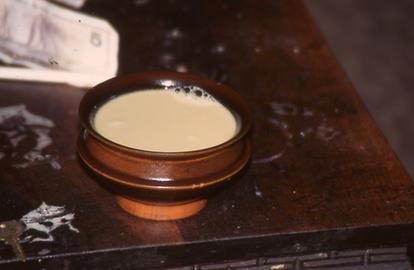



Butter is of major importance in Tibetan cuisine. It is supplied by the Yak, a highland cattle that provides extra fat milk. At lower altitudes, also a mixture of Yak and cattle, the Dzo, and domestic cattle are kept. There is even a monument of the Yak in Lhasa, that shows the importance of this animal.





The animals are delivering sufficient milk for butter in summer months, only. The nomades have special butter churns as they were also used in former times in Alpine regions.
The butter produced in summer has to be sufficient for the whole winter. It is sewn into a leather skin which was used as trading unit. Over time the storage it oxidized and turns rancid. This contributes to the western stereotype that Tibetans drink tea with rancid butter.
Exept for food, butter is used as fuel for the countless butterlamps in temples. The believers buy nicely and neatly packed butter to be offered in front of a monastery.
Cheese is also an important Tibetan food. It is not produced from beef stomach, because the killing of animals is forbidden. It is a very hard sour milk cheese which can be found in the markets where a string holds together small pieces of cheese.
Monastery kitchens are usually large rooms that are equipped with kitchen utensils, pots and pans and where fire places are kept. The cultural change is already noticeable. Where once wood and yak dung served as fuel, today electricity and liquid gas are used. Monks of lower ranks are working in the kitchen.
Since the opening of Tibet to tourism at the end of the 90s of the 20th century restaurants have been opened that are flourishing not only in Lhasa and bigger cities, but also along the highways. Often labeled multilingual, they advertise in Tibetan, Chinese and English and offer not only traditional food but also western food. They usually don’t look very inviting.






One innovation is also reflected in the fact that more elaborate pastries are becoming available. This is due to the import of staple food from the Chinese inland and the progressive technical modernisation of kitchens. Formerly, rice was a delicacy that was only available to the wealthy and that was brought in by caravans over thousands of kilometers from southern China. Today it is already very common and not seen as anything special any more.
The fact that the original restriction on tsampa could not be sufficient for the physical condition of the highlanders is clear. This opened a cultural conflict. On the one hand, not enough of animal protein was availabel. On the other hand, the Buddhist ideology of nonviolence prohibits the slaughter of animals and fish. To circumvent the commandment two pragmatic paths were found. Non-Buddhists were employed and even in smaller villages small groups, especially Uigurs, took over the profession of slaughterers and butchers.
This was easier to accomplish in small settlements. Mobile living nomads had problems. The arguments were as follows: What is slaughtering? This is the opening of carotid arteries so that the animal bleeds out. If you strangled the animal, however, or it drive against a cliff, over which it takes a fatal fall, this is an act which causes the death of the animal, but is not slaughter.Also, the animal is to blame in this case since it was so clumsy to falloff the cliff. And thus meat was available as needed. Therefore, meat from Yaks and Dozs, sheep and goats in all desired quantities is offered mainly in the markets. The monks are not shy to eat this kind of meat. However, they speak a prayer before the consumption. They thank the animal and give the animal hope for a good rebirth.





A special kind of preservation is dehydration of the whole body of the animal. Especially goats dry out in a bizarre quasi kneeling position in the cold and dry air of the highlands and therefore remain preserved almost unlimited.
Literature#
- Karin Brucker – Christian Sohns, Die tibetische Küche. 108 Köstlichkeiten vom Dach der Welt. München 2003
- Alexandra David-Neel, Gargantua au pays des neiges. Saumune 1993
- Rinjing Dorje, Food in Tibetan Life. London 1985
- Betty Jung, The Kopan Cookbook. Recipes from the kitchen of a Tibetan Buddhist Monastery. Kathmandu 1997²
- Indra Majupuria – Diki Lobsong, Tibetan cooking. Pioneer book on the food and cookery of the well known mysterious and one time forbidden land. Lushkar/Gwalior 1989²
- Tsering Wangmo – Zara Honshmand, The Lhasa Moon Tibetan Cookbook. Ithaca/NY 1999












